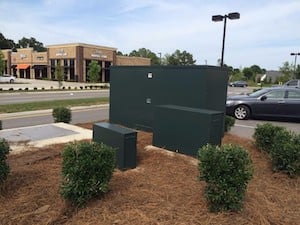 Based on a range of misconceptions, many municipalities have decided on underground backflow enclosures and meters. Among the reasons are that above-ground enclosures are large and take up too much space, they are bulky and not aesthetically appealing, and they expose equipment to vandalism.
Based on a range of misconceptions, many municipalities have decided on underground backflow enclosures and meters. Among the reasons are that above-ground enclosures are large and take up too much space, they are bulky and not aesthetically appealing, and they expose equipment to vandalism.
Not only are these reasons not valid, but also the mistaken ideas put water systems at risk for serious problems — from cross-contamination to injuries and, even, death. Experience and in-the-field reporting have proven time and again that putting all backflow equipment and meters in outdoor, above-ground utility enclosures is not only the safest but also most cost-effective housing option.
Avoid the Risks of Above-Ground Backflow Enclosures
Typically, merely for the sake of aesthetics, cities unwittingly put their communities at danger when they install underground backflow enclosures. But, when things go wrong in a vault, they can go horribly wrong. Here are the three leading risks.
1—Flooding and Cross Contamination
Backflow preventers are critical for protecting our water supplies. Importantly, they keep contaminated water from coming in contact with drinking water. When backflow preventers are installed in utility vaults, it increases the risk of cross-contamination from flooding. Case in point, the city of Corpus Christi, TX, suffered multiple water contamination incidents. These were not from installing backflow preventers in utility vaults, but because there were none installed at all.
All the stagnant, muddy, dirty water that rushes in and builds up can get sucked through the backflow preventer’s test cocks. From there, the dirty water can easily access the underground backflow enclosures and pollute local clean drinking water. As a result, the valve that is meant to protect polluted water from mixing with clean water can’t do its job. The floodwater then gets into the community, including citizens’ homes and businesses’ workplaces.
2—Worker Injuries
The Bureau of Labor Statistics reports that nearly 100 injuries occur annually related to working in confined spaces. The dangers for the people who test backflow preventers in confined spaces include:
- Breathing or touching poisonous gasses
- Oxygen deficiency
- Exposure to combustible dust
- Exposure to radiation
- Mobility limitations during entry and exit
- Entrapment
- Dangerous animals and poisonous insects
3— Worker Deaths
Reports from the Bureau of Labor Statistics and the Census of Fatal Occupational Injuries Program show that over 100 people die in confined spaces each year. All of the sources for worker injuries listed above can also, in serious cases, lead to workers’ on-the-job deaths.
Installing backflow preventers and meters in underground utility vaults is an unnecessary liability for water jurisdictions. Above-ground enclosures are much safer and more cost-effective. More importantly, they remove the threat of confined-space injury, flooding, property damage, death, and more.
This is why a growing number of jurisdictions are opting to install above-ground backflow enclosures and meters. Here are two examples:
Las Vegas, NV: The Las Vegas Valley Water District decided that standardizing the use of above-ground backflow prevention assemblies made the most practical and financial sense. Rather than incur the cost of constructing and rehabilitating concrete underground vaults, aboveground enclosures need only a concrete pad, which drastically lowers the cost of construction and the time required for installation. The district discovered that as much as $60,000 could be saved when installing backflow prevention assemblies and meters in the same outdoor, above-ground enclosure.
New Jersey: The state decided to update its guidelines to require above-ground installation for all new non-residential meters and containment backflow preventers. It found that outdoor, above-ground enclosures were easier to access for testing and maintenance, reduced annual maintenance expenses, and eliminated the need for representatives to depend on building occupants for access to meters. More importantly, moving meters and containment backflow preventers above-ground helped reduce injuries, property damage, and loss of life.
To keep your community safe, we strongly recommend that best practices in backflow enclosures and meters include outdoor, above-ground units.




